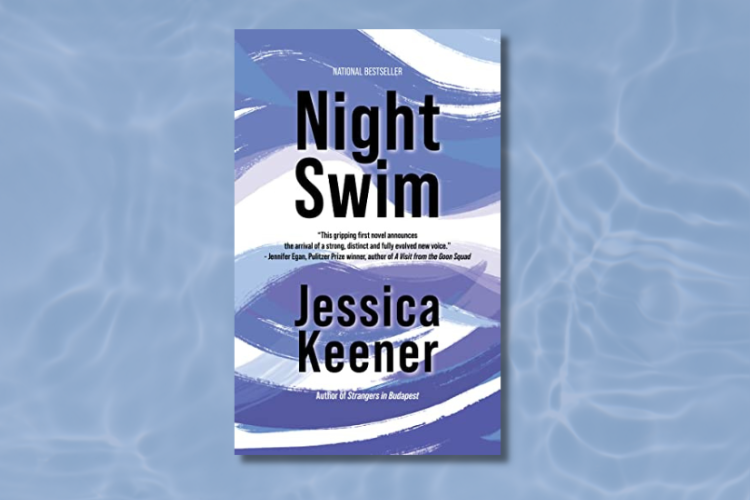
Jessica Keener’s Night Swim, A Decade Later
Set in the pivotal summer of Sarah Kunitz’s life, Night Swim (Vitis, $16.95) offers a nuanced and tender portrait of teen-age angst, confusion and ultimately triumph. Fiction Editor Yona Zeldis McDonough talks to novelist Jessica Keener about what makes Sarah run.
YZM: This is a special, tenth anniversary edition of the novel—what was the occasion for the reprint and what are some of the ways the novel can be read differently now?
JK: The story of Night Swim, which is about a dysfunctional Jewish family in 1970, and a coming of age of Sarah Kunitz, is set in a chaotic and divisive time in America. The Vietnam War, racism, shifting gender roles, and sexism collided and erupted and led to much unrest. My publisher and I decided to bring out an anniversary edition this year (2023) in part because of the reversal of Roe v. Wade, in part because of the growing awareness of institutional racism in America, and in part because of our country’s ongoing struggle to adequately address mental health issues and their impact on our families and schools. The question of a woman’s reproductive rights at the time of the novel’s debut seemed untouchable and curious to me, the role of Black maids in upper middle-class Jewish homes largely overlooked by reviewers when the novel first came out. Revisiting Night Swim a decade later presents an opportunity to reexamine these issues with greater depth and perspective, and to reconsider how we view ourselves today.
YZM: Sarah grows up in a house full of males with only her not-entirely-stable mother as the only other female; how does this affect her?
JK: Sarah finds comfort in her relationships with her three brothers, but her mother is someone who, without giving away the story, is unable to be present and available for her. As a result, young Sarah lives with an emotional void inside her, which also creates a buried sense of powerlessness. She fills this void with her singing and music. In her teenage years, when her life is heavy with crushing loss, she engages in sexual experimentation as a way to free herself from her grief, not understanding the consequences of her impulses.
YZM: At first, Sarah does not respond to the antisemitic taunting from the girls at school but later she does; how does her reaction evolve?
JK: The antisemitic incident in the novel is based on something that happened to me in Junior High. So, speaking from personal experience, I’ll say that when something like this happens, I think it’s common to feel fear and anger but also disbelief at first and the idea of taking action or strategizing a response comes later. For Sarah, when the girls taunt and throw a lit cigarette at her, she decides to keep her emotions in check. She’s mortified and angry but she doesn’t want those girls to think they have the power to hurt her. So, she hardens herself. This is characteristic of Sarah, who too often tries to take on burdens that ought to be shared—either with a stable adult or friends. But after the second bully incident, she sees that withholding her reaction won’t stop them. That’s when she seeks the help of a boy at school who likes her. She asks him to protect her and her friend. This proved successful in ways she didn’t expect.
YZM: How has the conversation about the role of Black maids in Jewish households changed over time?
JK: I’m glad you asked this question because I’m not sure there has been any in-depth conversation around this. Recently I watched a documentary produced by Barack and Michelle Obama called “Working: What We Do All Day.” I learned that 65 percent of home care workers are people of color. Home care workers are not Black maids, but I think there’s a correlation between the two. Both positions are low paying, offer little incentive for growth and benefits, and can be physically and emotionally demanding. Yet, they make a huge difference to those who need their care—particularly the aged and infirm and family members who rely on them. Today, my 98-year-old mother lives in a Senior Living facility where most of the caretakers are Black. As a society, we can do better by paying caregivers a living wage. But that won’t happen if we don’t look closer and honestly at the key role these workers play in all of our lives.
YZM: Let’s talk about the issue of reproductive rights as they play out in the novel; Sarah could not get a legal abortion at that time; did you ever imagine that she would face similar restrictions today?
JK: When I wrote Night Swim, I wanted readers to experience what one upper middle class teenage girl would face in 1970 should she have an unwanted pregnancy. What would it involve? What would it cost? Would it require travel? Secrecy? Shame? Where would she go for help? The only state that allowed a legal abortion at that time was New York. A few years later, in 1973, the Supreme Court ruled to protect a pregnant women’s right to choose abortion, regardless of what state she lived in. Never, in my wildest dreams did I imagine this right, cemented into law for fifty years, would be revoked. But here we are, back in 1970, fighting for full ownership of our own bodies again. It’s an unfortunate recurrence that thrust Sarah back to the future.



